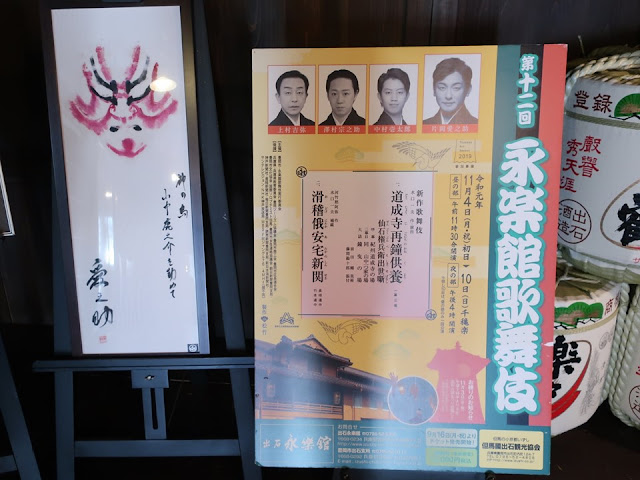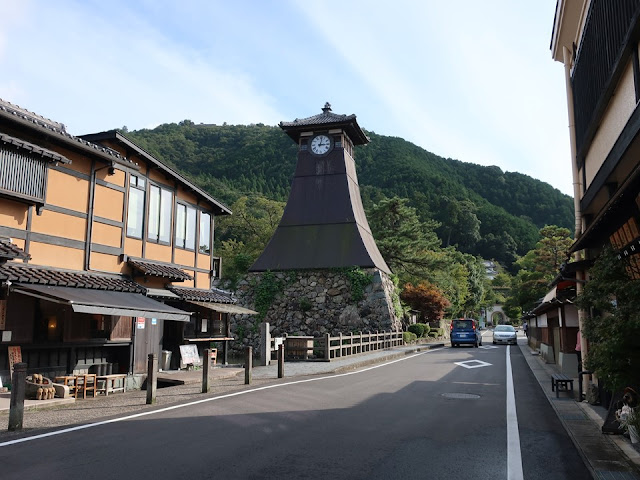Izushi (Hyougo prefecture) is located at north of Osaka. It is a good old town which has “Preservation Districts for Groups of Traditional Buildings” designated by Japanese government.
The oldest existing theater in Kansai
region “Eirakukan” attracts me. It opened in
1901, and various plays were performed such as Kabuki and films. However, it
was closed in 1964 because TVs or other entertainments took place of it.
It was renovated and reopened in 2008, and regains
its bustle. Ainosuke Kataoka who is a popular Kabuki actor played here every
year. We can imagine the voices of cheering people easily.
出石町は、兵庫県北部の豊岡市にあります。城下町で、重要伝統的建造物保存地区がある町です。
私のお目当ては、近畿地方に現存する最古の芝居小屋だという「永楽館」です。明治34年に開館し、歌舞伎や映画など様々な公演を行いましたが、「テレビの普及、娯楽の多様化など」で昭和39年に閉館。しかし、修復して、平成20年に杮落とし。人気俳優・片岡愛之助が公演するなど賑わいを取り戻しました。ここで、やんやの歓声が上がっていたと思えるのが嬉しいです。
View from the second floor; maximum capacity is 350. There are retro signboards on the side walls which were designed in the Showa period (1926-1989).
二階席から見た劇場。最大収容人数は350人です。両サイドには復元した昭和レトロな看板があります。
View from the first floor; Ayumi(walking)-ita(board), which waitresses delivered food and drink, are set. The width is almost same as a balance beam of gymnastics. Waitresses had to be good athletes.
Chairs are set now, but people used to sit down on the floor.
一階席に座ってみるとこんな感じ。女性が「あゆみ板」を行き来して飲食を給仕してくれたといいます。平均台ぐらいの幅なのでバランス感覚は大したものです。
今は椅子を置いていますが、昔は座敷だけだったとのことです。
Actors can move under the runway. Its entrance is called “Toya”.
花道の下に入る「鳥屋」(とや)は奈落へ続きます。
Actor gets on the board here and appears on the runway. Four men shoulder the board.
四人で台を担いで、役者を持ち上げて、役者を花道に飛び出させます。「スポン!」と飛び出るので「すっぽん」と言うのだそうです。
This is a revolving stage which diameter is 6.6m. A stage elevator is also equipped. But those are manual machines.
回り舞台(直径6.6m)の下。もちろん、セリも付いています。但し、人力で回して、人力で上げます。
View from the stage、舞台からはこんな感じです
There is a shelf above the stage; staff scatter confetti and so on. Those are similar to a big theatre.
舞台の上は、紙吹雪などを演出する葡萄棚。この上から、紙を舞わせます。
There is a two-story booth on the right. Performers sing and play the drum, the Japanese guitars and the flutes. It’s so small. There is also a seat for the owner of the theater just in front of the booth.
舞台の横には、太夫が唄い、笛や太鼓、三味線のお囃子を奏でるスペース。狭いです。そして、その前は館主の席です。
Behind the screen of the stage are small make-up rooms. There is a bathroom to remove makeup, too.
舞台の裏には化粧部屋がありました。舞台とは幕で仕切ります。化粧を落とすお風呂は舞台の袖にあり、コンパクトに纏まっています。
[2025年7月追記] 2025年のヒット映画「国宝」のワンカットはこちらの化粧部屋で撮影されたそうです。
Popular Kabuki actor Ainosuke has a one-week play every year. He likes Izushi! Audiences also like this theater because they can see actors up close. That makes sense.
愛之助さん、一週間の公演でした。出石の町はお気に入りとのこと。観客にとっては、役者を間近に見ることができる人気の劇場だそうです。なるほど。
There was a pier in front of Eirakukan. Water transportation was major before trains and trucks took place of it. This used to be a busy place.
永楽座の前には船着き場がありました。鉄道やトラック輸送がメインになる前は、何と言っても水上輸送でした。永楽館の前は賑わっていたと思います。
Walking around Izushi、出石町散策
View from the castle site: This small town far from the urban area and is surrounded by mountains. So, I am impressed by the fact that many people visited Eirakukan. However, people didn’t visit after TV became popular. TV was a dominant factor of entertainment.
出石は山に囲まれていて、大きな町ではないし、周りに大きな町もありません。よく永楽館に人が集まったものだと思います。しかし、TVの普及とともに、人々は芝居小屋に来なくなりました。娯楽=人の楽しみに対するTVの影響は決定的ですね。
This is an iconic tower “Shinko-rou(tower)” which was built in 1781. People were used to be informed with the time by the sound of the drum. Thereafter, a doctor donated the clock; the oldest clock tower in Japan.
出石の観光名所は辰鼓楼ですね。1871年に建設されたそうです。時計は十年後に医師が寄付して日本最初の時計台になりました。それまでは、太鼓で時を知らせていたとのこと。いいですね。
There are forty-four soba noodle restaurants in this area. Izushi soba is famous.
八木通りはそば屋さんだらけです。半径2km圏に44件のそば屋さんがあるそうです。
We had it at this old restaurant “Soba shou”.
名物の出石そばは「そば庄」さんでいただきました。
Many soba plates and various seasonings were served; it’s Izushi style. I was surprised that raw eggs were served, but it’s good. The daimyo lord brought soba cooks, when he came to Izushi from Nagano which has lots of soba restaurants.
小皿に盛り付けて色々な薬味とともに楽しむのが出石そばです。生卵が薬味なのが驚きでしたが、いけます。信州上田藩主の仙石氏がそば職人を連れてきたのが始まりだそうです。
This is a small museum “Ashigaru (infantry) Nagaya (apartment)”, but it was closed when I visited. There is a historical museum in this town too.
足軽長屋(出石歴史文化交流館)を訪ねましたが、開館時間を過ぎており見学できず残念。また、出石史料館は定休日で見学できず、また、次回です。家老屋敷もあります。
Famous Kinosaki hot-spring resort is near Izushi. It was my first time in fifty years to stay there. An old-style shooting game establishment is still there. Visitors wore yukata kimono and played.
出石からほど近い、城崎温泉で泊まりました。50年ぶりです。射的屋さんは変わってないかも。
Visited in September, 2020
Official website: http://eirakukan.com/ (in Japanese), accessed
in November, 2020
Previous post (Famous castle ruins near Izushi):
TakedaCastle Ruins and Information center “Castle in the Sky”、竹田城と情報館「天空の城」
Next post (Old
theater in Izushi which is near Takeda town):
Kyoto Prefectural Tango Regional Museum、丹後郷土資料館




























Comments
Post a Comment